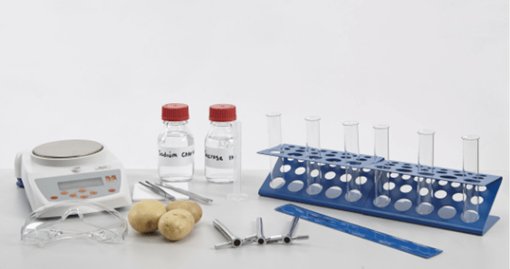Effect of osmosis on plant tissue

Effect of osmosis on plant tissue
Investigate the effect of a range of concentrations of salt or sugar solutions on the mass of plant tissue.
Students are required to investigate the effect of osmosis and water potential on the mass of plant tissue. They are required to use appropriate apparatus to prepare dilutions of sugar or salt solution and assess the effects of different concentrations by measuring the change and calculating the percentage change in length and mass of potato cylinders before plotting their results on a graph.

Equipment (per pair of participants)
If preparing own potato cylinders
• A potato
• Scalpel
• Forceps
• Cork borer
• White tile
• 15cm ruler
• Boiling tubes and rack
• 10ml measuring cylinder
• Top pan balance (measuring to two
decimal places)
• Sodium Chloride/Sucrose
• Deionised water
• CLEAPSS Hazcards: 40C, 47B
Method
- Students must prepare five identical potato cylinders by using a cork borer to remove them from a potato. These must then be trimmed carefully using a scalpel to remove any potato skin, and they should be cut to ensure that the cylinders are all roughly the same length.
- They should then accurately measure the length of the potato cylinders and record them in a suitable table.
- Using a 1 molar solution of either sucrose or sodium chloride, students must dilute the solution using serial dilution so that they have four different concentrations of their solution (including the 1 molar solution).
- Five boiling tubes should be labelled, one as ‘water’ or ‘zero’ and the rest with the concentrations of the solutions.
- Students should then weigh their potato cylinders, one by one, using a 2 decimal place balance and record the masses in their table.
- They should then accurately measure 10mls of each of their solutions and add these to the appropriately labelled boiling tubes. 10mls of water should be added to the tube labelled ‘water’ or ‘zero’.
- One potato cylinder is then placed into each of the boiling tubes.
- The tubes should then be left for a set amount of time, as long as possible given the time constrains of the practical session. A water bath at 30°C can help things along and give a more noticeable change.
- Once the set time has elapsed, students can remove the potato cylinders from the tubes one by one and re-measure the length and mass of each cylinder, recording the measurements in their table.
- Students then work out the change in mass and length of the cylinders and then calculate the percentage change in the mass and length.

Technician tips
• 1L of accurate 1M sucrose solution is made by adding 342.3g of sucrose to 750mls of deionised water, heating slightly and stirring to dissolve and transfer the solution via a funnel into a volumetric flask. Use a wash bottle to rinse any remaining sucrose solution from the beaker and funnel into the volumetric flask and then fill the volumetric flask to the meniscus line. Insert the stopper and invert the flask several times to fully mix.
• 1L of accurate 1M sodium chloride solution is made by adding 58.44g of sodium chloride to 750mls of deionised water, heating slightly and stirring to dissolve and transfer the solution via a funnel into a volumetric flask. Use a wash bottle to rinse any remaining sodium chloride from the beaker and funnel into the volumetric flask and then fill the volumetric flask to the meniscus line. Insert the stopper and invert the flask several times to fully mix.
• This accurately prepared solution can then be diluted by students to prepare the lower molarity solutions.
• Potato cylinders could be prepared for students in advance to negate the need for the use of sharp implements in the classroom. Pre-preparing the cylinders also ensures that potato waste is kept to a minimum. The cylinders need to be completely skinless for them to be the most effective.
• If students are preparing their own cylinders, a supply of plastic straws can be helpful to remove the potato cylinders from the cork borers.
• An electronic water bath could be provided and set at 30°C. Placing the tubes in the water bath and leaving them for 30 minutes will give a more noticeable change in mass and length.
Investigate the effect of a range of concentrations of salt or sugar solutions on the mass of plant tissue. The experiment involves using an apparatus to prepare dilutions of sugar or salt and assess the effect of different concentrations. To do this practical students will need safety googles, ruler, class dissection bundle, cork borer set, boiling tube, boiling tube rack, 10ml measuring cylinder, white tile, top pan balance, sodium chloride, sucrose, deionised water, digital water bath and volumetric flask. Shop our full range of biology equipment at Philip Harris.










